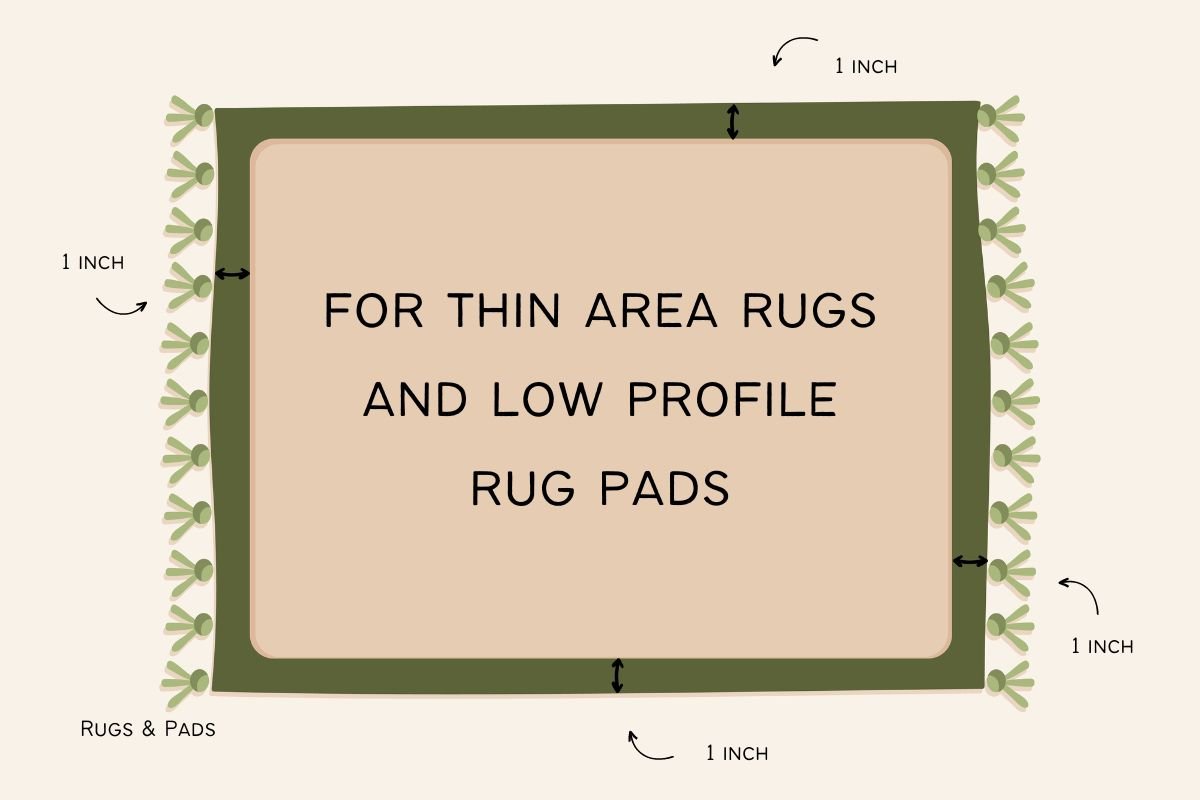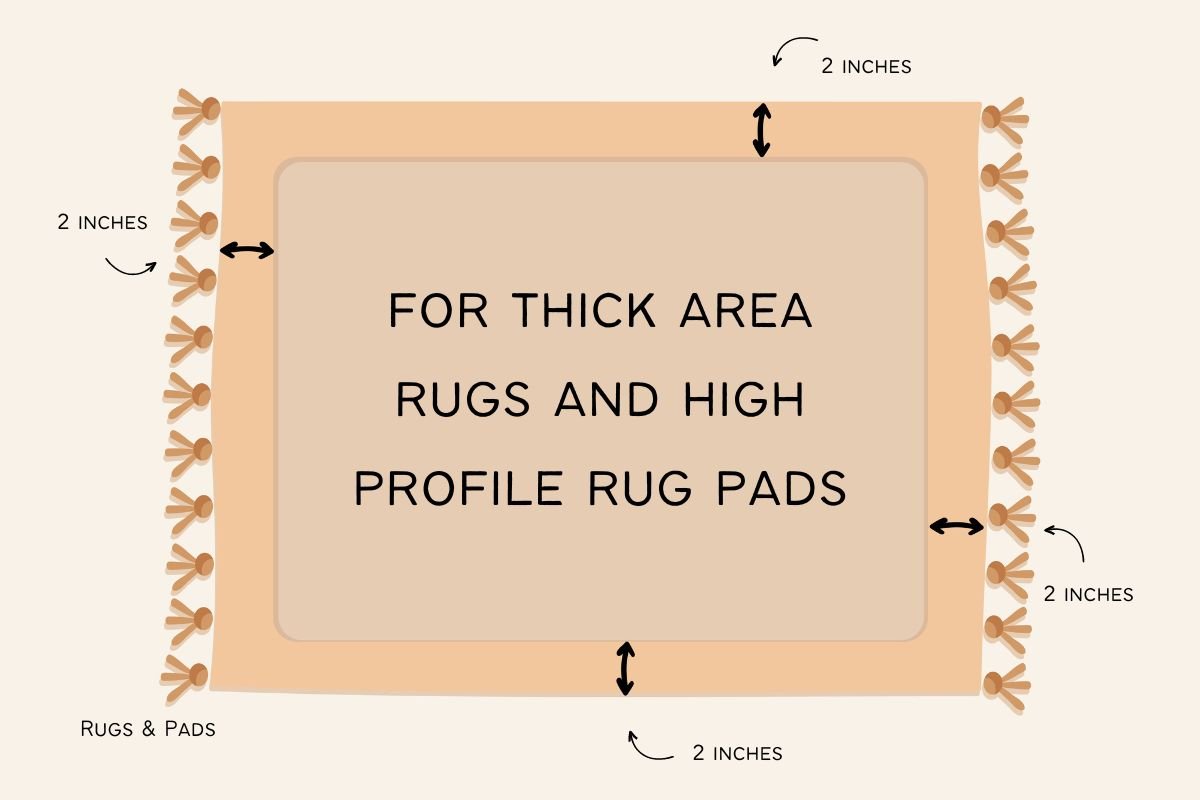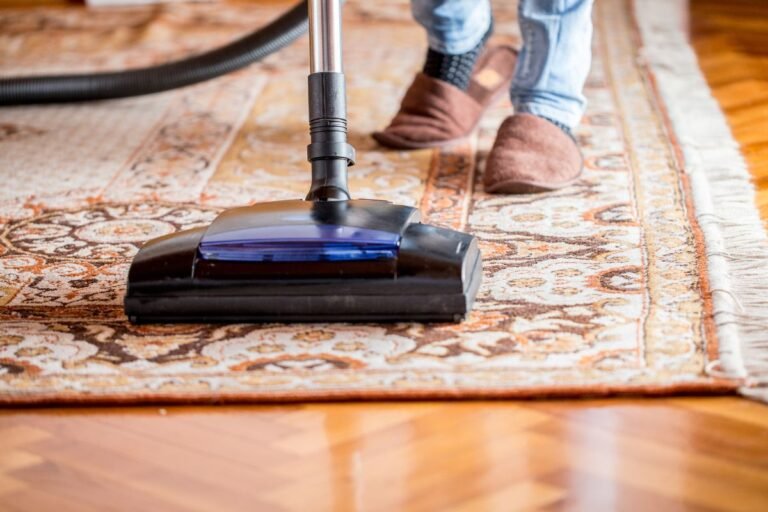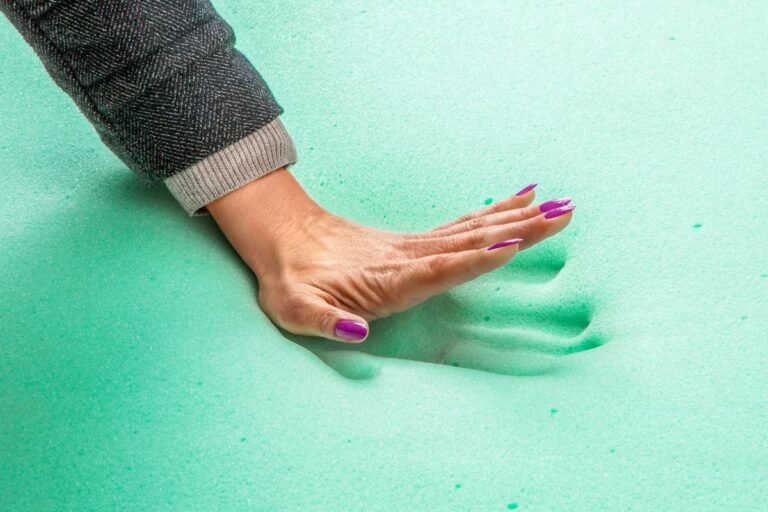Want to know how to size a rug pad? Same.
While it seems like you’d want a rug pad that’s the same size as your gorgeous area rug, that’s just not the case.
I’ve worked in the industry for a few years and a good rule of thumb is this: a rug pad should be one inch shorter on all four sides of the area rug. So a 4 foot x 6 foot area rug would need a 3 foot 10 inches x 5 foot 10 inches rug pad.
But what is the difference between a thin rug and a thick rug? And one in high traffic areas versus one that is just for extra cushioning?
That’s what I’ll break down for you here.
Whether you’re trying to save your downstairs neighbors or you just want your GD area rug to stop slipping around, I’ll help you find the proper rug pad size.
Here are the steps to finding the exact size you need for your rug pad.
Measure the area rug
First things first, you need to know the exact size of your area rug. The first step is to measure the length and width of the area rug.
Most area rugs will work with this general formula. Most rug pads are between 1/8 inch and 1/4 inch thick.

Be sure to measure from the widest points of the rug to ensure accuracy.
- Start by measuring the length of the rug: Measure the longest side of the rug, from one end to the other. Make sure to measure along the outer edges of the rug, rather than from any tassels or fringes.
- Next, measure the width of the rug: Measure the shorter side of the rug, from one end to the other, again along the outer edges of the rug.
- Take note of the exact measurements: Be sure to write down the exact length and width of the rug. It’s important to be as precise as possible, so use a tape measure or ruler to get accurate measurements.
- Subtract 1 inch from each side: When selecting a rug pad, it’s recommended to choose a rug pad that is slightly smaller than your rug. To do this, subtract 1 inch from each side of your rug. For example, if your rug measures 6 feet by 8 feet, subtract 2 inches from each side, resulting in a rug pad size of 5 feet 10 inches by 7 feet 10 inches. This will allow the rug pad to fit just inside the edges of the rug, providing ample coverage and cushioning while preventing the rug from slipping or sliding.
- Repeat for irregularly shaped area rugs: If you have an irregularly shaped rug, such as a circular or octagonal rug, measure the widest point of the rug in all directions, then order a rectangular shaped rug pad according to those longest measurements. You can then cut the rug pad to size with a utility knife or sharp scissors to get exactly the right size. The same rule applies here: the rug pad should be about 1 inch shorter all the way around. Two inches shorter if the rug pad is extra thick.
If you want to prevent premature wear on your area rug or extra floor protection, then a felt rug pad with rubber padding is the right rug pad for you.
Be sure to go with a high quality rug pad that won’t ruin your floors. That’s why I consistently recommend the Superior-Lock Rug Pad. It has a natural rubber backing so that it won’t move around on any hard surface, and it also won’t damage your floors.
If you’re not looking for the non-slip action and you just want extra cushioning, then subtract two inches from all four sides of the area rug and use heavy furniture legs to keep it in place (on top of your area rug, of course).
Which leads us into my next tip…
Add extra space for thick rug pads
When it comes to selecting a rug pad, the thickness of the pad can play a role in determining the appropriate size. An area rug pad that is thick and plush can compress over time, which may cause the rug to shift or bunch up if the pad is too small.
For anything thicker than 1/4 inch, you’ll want to start adding a little extra space for the area rug to cover the height.

By selecting a rug pad that is 2 inches shorter on each side, rather than just 1 inch, you allow for extra coverage from the area rug. The weight of the area rug helps to compress the rug pad, which can help to prevent bunching or shifting over time.
The extra material from the area rug that extends beyond the edges of the rug pad can also provide additional cushioning and support, which can be especially helpful with thicker rug pads.
A rug pad that is too small can cause the edges of the rug to curl or fray over time, as the edges are more susceptible to wear and tear. By allowing for extra coverage, you can help to extend the life of both the rug and the rug pad.
PRO TIP: If you have a thick rug pad, it can be helpful to choose a rug pad that is 2 inches shorter on each side to ensure proper coverage and prevent any issues with shifting or bunching over time.
Consider the shape of the rug
If your rug is a unique shape, such as a round or oval rug, it may be more difficult to find a rug pad that fits perfectly. In this case, you may need to purchase a slightly larger rug pad and trim it to size.
The same rules for sizing a rug pad generally apply to circular and oval shaped area rugs. However, the measuring process may be slightly different.
To size a rug pad for a circular or oval rug, follow these steps:
- Measure the diameter of the circular rug: Start by measuring the widest point of the circular rug, from one edge to the opposite edge, passing through the center of the rug. If you have an oval rug, measure the longest length and the widest width.
- Subtract 1 inch from the diameter: To determine the appropriate size for the rug pad, subtract 1 inch from the diameter of the circular rug. For example, if your circular rug has a diameter of 8 feet, subtract 1 inch to get a rug pad size of 7 feet 11 inches.
- Look for a circular or oval rug pad: When shopping for a rug pad, look for one that is circular or oval in shape and matches the size of your rug pad. Many rug pads can be trimmed to fit irregularly shaped rugs, but it’s best to start with a pad that is the correct size and shape whenever possible.
Choose the right thickness
Rug pads come in a variety of thicknesses, from thin and lightweight to thick and plush. Consider the thickness of your rug and the amount of cushioning you desire when selecting a rug pad.
Take the quiz to find the right match for your floors:
Not sure which rug pad to get?
Take the quiz to get started!
We recommend:
It basically comes down to this:
- anything less than 1/4 inch thick, cut 1 inch from each side of the area rug
- anything thicker than 1/4 inch, add to the 1 inch from each side; thicker rug pads might need 2 inches.
When choosing a rug pad thickness, there are a few factors to consider:
The type of flooring
If you have hardwood or tile floors, a thicker rug pad can provide extra cushioning to help prevent damage to your flooring. If you have carpeting, a thinner rug pad may be sufficient to prevent slipping and sliding.
The thickness of the rug
If your area rug is thick and plush, a thinner rug pad may be all that is needed to provide the necessary grip and cushioning. If your rug is thin, a thicker rug pad can help to add some extra padding and comfort underfoot. Generally speaking, the thicker your rug pad, the more you have to trim from the measurements of your area rug.
The level of foot traffic
If your rug is in a high-traffic area, a thinner rug pad may be better to prevent slipping and bunching. Living rooms, where there is a lot of activity but not necessarily consistent foot traffic, would be better off with thick rug pads that provide comfort. Thinner rug pads need fewer inches taken off to fit under the area rug. Thicker rug pads need more cut down to fit underneath an area rug.
Flatweave Rugs
Flatweave rugs are generally thinner and do not require as much cushioning as thicker rugs. A rug pad that is 1/8 inch to 1/4 inch thick should be sufficient to prevent slipping and provide some extra cushioning underfoot.
Rugs Where You Want Extra Cushioning
If you want extra cushioning underfoot, such as in a bedroom or living room, a thicker rug pad is recommended. A pad that is 1/2 inch to 1 inch thick should provide plenty of cushioning for a plush, comfortable feel.
Rugs in Common Areas
For rugs in common areas such as living rooms or dining rooms, a medium-thick rug pad that is 1/4 inch to 1/2 inch thick should be sufficient. This thickness will provide enough cushioning to make the rug comfortable to walk on, without being too bulky or thick.
Personal preferences
Ultimately, the thickness of the rug pad you choose may also depend on personal preferences. Some people prefer a thicker, more cushioned feel underfoot, while others may prefer a thinner pad for a firmer feel.
In general, rug pads are available in a range of thicknesses, from less than 1/4 inch to 1/2 inch or more. For hardwood or tile floors, a pad that is at least 1/4 inch thick is generally recommended to provide adequate cushioning and protection. However, if you prefer a more plush feel underfoot, a thicker pad may be more suitable.
It’s always a good idea to read product descriptions and reviews carefully to get a sense of the thickness and durability of different rug pads, and to choose one that is appropriate for your specific needs and preferences.
Check the material
Rug pads can be made from a variety of materials, such as felt, rubber, or foam. Consider the type of flooring you have and the type of rug you are using when selecting a rug pad material. For example, if you have hardwood floors, you may want a rug pad with a natural rubber backing to prevent slipping without damaging floors.
Felt
Felt rug pads are a popular option for hardwood, tile, and other hard flooring surfaces. Felt pads are dense and provide a thick layer of cushioning underfoot, making them ideal for high-traffic areas or for adding extra padding to thinner rugs. Felt pads are also great for reducing noise, as they absorb sound and prevent echoing.
Natural Rubber
Natural rubber rug pads are best for use on hard flooring surfaces like tile, laminate, and concrete. Rubber is highly durable and provides excellent grip, preventing rugs from slipping and sliding. Rubber pads also help to protect floors from scratches and other damage, making them ideal for use under heavy furniture or in high-traffic areas.
Natural Rubber and Felt
Natural rubber and felt rug pads are a combination of dense felt and natural rubber, offering the benefits of both materials. These rug pads are ideal for hardwood and tile floors, providing both cushioning and grip to prevent slipping and sliding. They are also highly durable and can withstand heavy use over time.
Memory Foam
Memory foam rug pads are a popular option for adding extra cushioning to thicker rugs, making them ideal for use in bedrooms or other areas where comfort is a top priority. Memory foam pads are also great for reducing noise and absorbing shock, making them a good choice for high-traffic areas.
Ultimately, the best rug pad material for your floor type will depend on your specific needs and preferences. Consider the type of flooring you have, the thickness of your rug, and the level of foot traffic in the room, and choose a rug pad that is appropriate for those factors.
Closing Thoughts
The right size rug pad first depends on your actual rug size plus how thick you want your rug pad to be. If you have a high quality area rug, then you’ll also want to make sure that you’re selecting a high quality rug pad that won’t damage your floors or your area rugs. That’s why I always go with RugPadUSA. I hope these tips have helped!! Let me know what you go with 🙂
More About Rug Pads
- The 5 Best Rug Pads for Hardwood Floors
- How To Secure Area Rug On Top Of Carpet (The Safe Way)
- Best Non-Toxic Rug Pads Safe For Children And Pets
- How To Size A Rug Pad, Expert Tips
- The Best Memory Foam Rug Pad for Maximum Comfort
- Best soundproofing rug pads: 3 options for a quiet barrier
- This Is The Best Rug Pad For Vinyl Plank Flooring
- Rug Pad Thickness Guide: How To Choose Rug Pad Thickness











